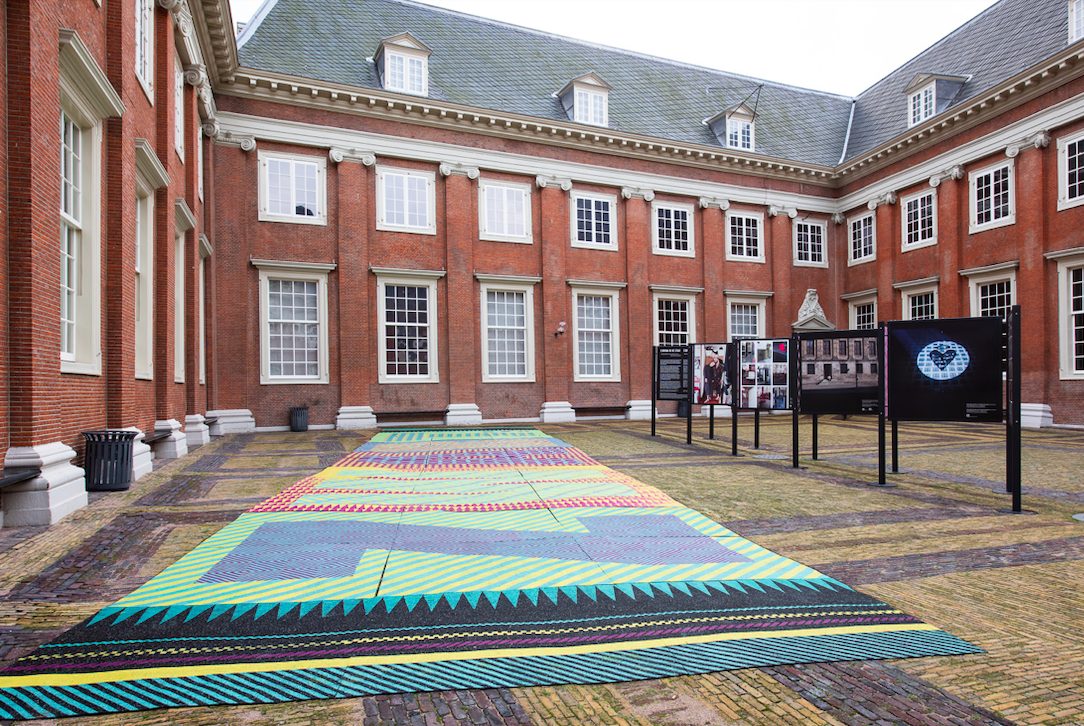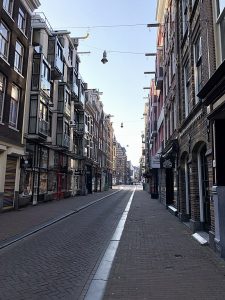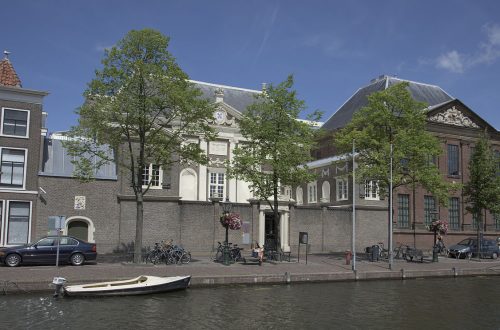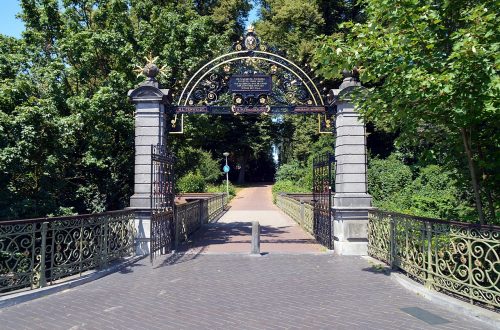
Corona in the city. A crowd-sourced on- and offline exhibition (Amsterdam, the Netherlands)
The digital exhibition Corona in the city is about the impact of Corona on the city and its inhabitants and documenting this for the future real time. After one year more than 3000 photo’s, video’s, story’s, drawings, magazines, columns, letters, poems, interviews and songs have been collected and are shared on the exhibition website. The digital exhibition has been visited by more than 150.000 visitors in one year (15 may 2020 – 15 may 2021). For the corona in the city exhibition, not only the general public but also many organizations joined in, of which local strongly embedded media partners were most prominent. And this lead to greater exposure and themed rooms curated by many different organizations, artists and individuals. The exhibition is new in the way that the content is collected and curated by people from outside the museum world. The expectation would be that this makes the exhibition very inclusive.
Background

Situated in an orphanage building from 1578 in the heart of Amsterdam, the Amsterdam museum has changed its name from Amsterdam Historical Museum to Amsterdam Museum in 2010. This name change reflected its change from a more classical historical museum, glorifying the past of, for example, the much-contested Dutch ‘Golden Age’ to a museum actively and critically investigating the city’s past, present, and (so they say) even its future identity and story; “from a treasure trove to a networking production house”. One of their objectives is to make the citizens and visitors part of its story through participation and co-creation. They are actively collecting ‘the city’ and are collaborating with knowledge partners such as the University of Amsterdam. In 2025 they will organize an exhibition called “Collecting the city; 750 years Amsterdam” to commemorate the 750 years ‘anniversary of the city, a story mining project in which everyone with a story worth telling is invited to participate. In this way, the museum is actively carrying out these objectives. The museum receives structural support from the municipality of Amsterdam and BankGiro lottery.
The museum wants visitors to discover the past, present, and future of Amsterdam by focusing all their activities on the story, heritage, and identity of the city. And strengthen the bond between visitors and residents with the city, but also between residents themselves. One of the main goals of the museum is to focus on education. The museum is active in collaboration with schools and regularly launches educational projects (Amsterdam Museum sd).
The museum focuses on four different specific target groups: Amsterdammers, culture tourists, culture lovers, and families. These target groups have been established through market research and the current goals of the museum. The museum has adapted to these target groups by arranging specific events and activities for these target groups.
On average, the museum receives approximately 500,000 visitors per year. However, due to the Covid-19 pandemic, the visitor numbers have significantly changed a lot. In 2020, the museum received only 224,728 physical visitors. In addition, a new type of visitor had been added due to the digital projects that were started by the pandemic, namely online visitors. The number of foreign visitors has decreased, but the number of visitors from the city itself has increased (Amsterdam Museum 2020).
Description

The Amsterdam Museum and various partners wanted to do something to commemorate one year of corona in the city. So, they created a unique digital exhibition called: Corona in the city. This exhibition shows the impact of the Covid-19 virus on the daily life of the city of Amsterdam and its residents. After the plan was drawn up, all organizations involved ensured that it would be promoted to the people to send in stories and images. From April 30, 2020, all residents, visitors, and enthusiasts of Amsterdam could submit their experience with corona (Boon 2021).
In the end hundreds of people and organizations have created the exhibition by means of sending in stories, photos, videos, and audio fragments. A team places a choice of entries on the digital platform every week. In this way, the exhibition continues to expand and is interesting to visit again and again. Corona in the city opened to the public on May 15, 2020. In total, more than 150,000 people visited the digital exhibition.
The digital exhibition is divided into nine so-called halls. Nine different works can be seen in each room. The first rooms are devoted to themes such as Dam Square, The silent city, New behavior and Life in isolation. In addition, a few of the participating partner organizations show what stories and images they have collected in recent months and share them in their own given digital hall (Amsterdam Museum 2020).
The main aim of the Corona in the city exhibition is to connect residents in isolation, to give a broader context and historical interpretation to the crisis period and to capture this unique period in testimonies so that it can be told about this period in the future. This ensures that this exhibition has a unique heritage value for the Netherlands. In addition, the Corona in the city exhibition has achieved a goal of the museum to organize exhibitions and public activities for a large audience, despite the physical closure of the museum (Amsterdam Museum 2020).
The exhibition was made possible by several participants. First and foremost, are the people who submitted material for the exhibition. Without them it would not have been possible to make the exhibition. A team put together by the Amsterdam Museum ensured that the exhibition was created. In addition, there is a list of partners on the website who have helped and were involved. The partners are all from Amsterdam, and most of them are also active in the cultural sector themselves. The target groups of these partners also differ, which made it possible to reach a large audience with the promotion (Corona in de stad sd).
Impact
As a result of Covid-19, the first digital exhibition of the Amsterdam Museum: Corona came to the city. Organizing this was a new challenge for the Amsterdam Museum. When designing the exhibition, the museum had to adopt a new way of working. For example, because of the measures, staff were advised to work from home as much as possible, which meant that communication was completely online. In addition, the museum has entered into a partnership with more than 40 different partner organizations. Never before have so many partners been involved in previous exhibitions. Many of these partners were also new to the museum to work with (Boon 2021).
For this project, the museum worked in a multidisciplinary team consisting of (guest) curators, trainers, and marketing & communication specialists. Working in a multidisciplinary team was one of the most important learning points of the museum itself. The museum never made an exhibition with this kind of team before. The museum sees working in such a team as an option for future projects (Corona in de stad 2021). Another challenge was the time frame that the museum had to set up the exhibition. Normally a work has already been made, possibly an assignment, and then months, sometimes years go by and that is ultimately the exhibition. The time span for this exhibition was much shorter. Within a month the exhibition was published online (Boon 2021).
This exhibition involves the community in its implementation and is also intended for society. The exhibition responds well to current social situations and problems caused by, among other things, Covid-19. For example, the need for digital platforms has increased and the museum is responding to this by making the exhibition digital. In addition, the museum responds to the social problem that has increased due to Covid-19, namely loneliness. The social purpose of the exhibition is to bring people into contact with each other, to give people the opportunity to share stories (Lans 2021).
There were more visitors than expected with a total of 200 unique visitors. This is therefore one of the museum’s most successful exhibitions. The exhibition had a positive effect on the visitors. It gave them the feeling that they could tell their story on the platform. The museum expects that the exhibition will ensure that as soon as the museum opens again, more new visitors will come, and probably new target groups can arise (Boon 2021).
Interpretation
The exhibition is new in the way that the content is collected and curated by people from outside the museum world. The expectation would be that this makes the exhibition very inclusive. The question would remain if all the stories in the 78 online spaces would have found their way to the museum without this initiative, and browsing the outcome, it is safe to say; probably not. The exhibition was created with a large group of participants, and remains interesting to visit time and time again. The museum has learned a lot and sees potential for future innovative exhibitions. . During the lock down period it is safe to say that initiatives such as these have created a bond between isolated citizens. Initiatives as this could be perpetuated in future and can be therefore listed as a good practice as bonding will remain important for the social cohesion of a city or place.
References
- Organisation website; www.amsterdammuseum.nl
- Amsterdam Museum. 2020. “Amsterdam Museum Jaarverslag 2020.” Amsterdam Museum. Accessed December 2021. https://www.amsterdammuseum.nl/sites/default/files/am_jaarverslag_2020_website.pdf.
- —. n.d. Missie en Visie. Accessed December 2021. https://www.amsterdammuseum.nl/over-ons/over-de-organisatie/missie-en-visie.
- —. 2020. Over de tentoonstelling. Mei 15. Accessed December 2021. https://www.coronaindestad.nl/over-de-tentoonstelling/.
- Boon, Errol, interview by Zenna Lorenzo. 2021. Corona in de stad (December 12).
- Corona in de stad. n.d. Colofon. Accessed December 2021. https://www.coronaindestad.nl/colofon/.
- —. 2021. De totstandkoming van Corona in de Stad. September 15. Accessed December 2021. https://www.coronaindestad.nl/magazine/de-totstandkoming-van-corona-in-de-stad/.
- Lans, Jos van der. 2021. Een ideaal probleem. November 10. Accessed December 2021. https://www.groene.nl/artikel/een-ideaal-probleem.
- Monumentendag. n.d. Amsterdam Museum. Accessed December 2021. https://monumentendag.nl/locatie/amsterdam-museum/.
Author
- Zenna Lorenzo (Inholland University of Applied Sciences)
Header photograph
Erol Boon on Wikimedia Commons




